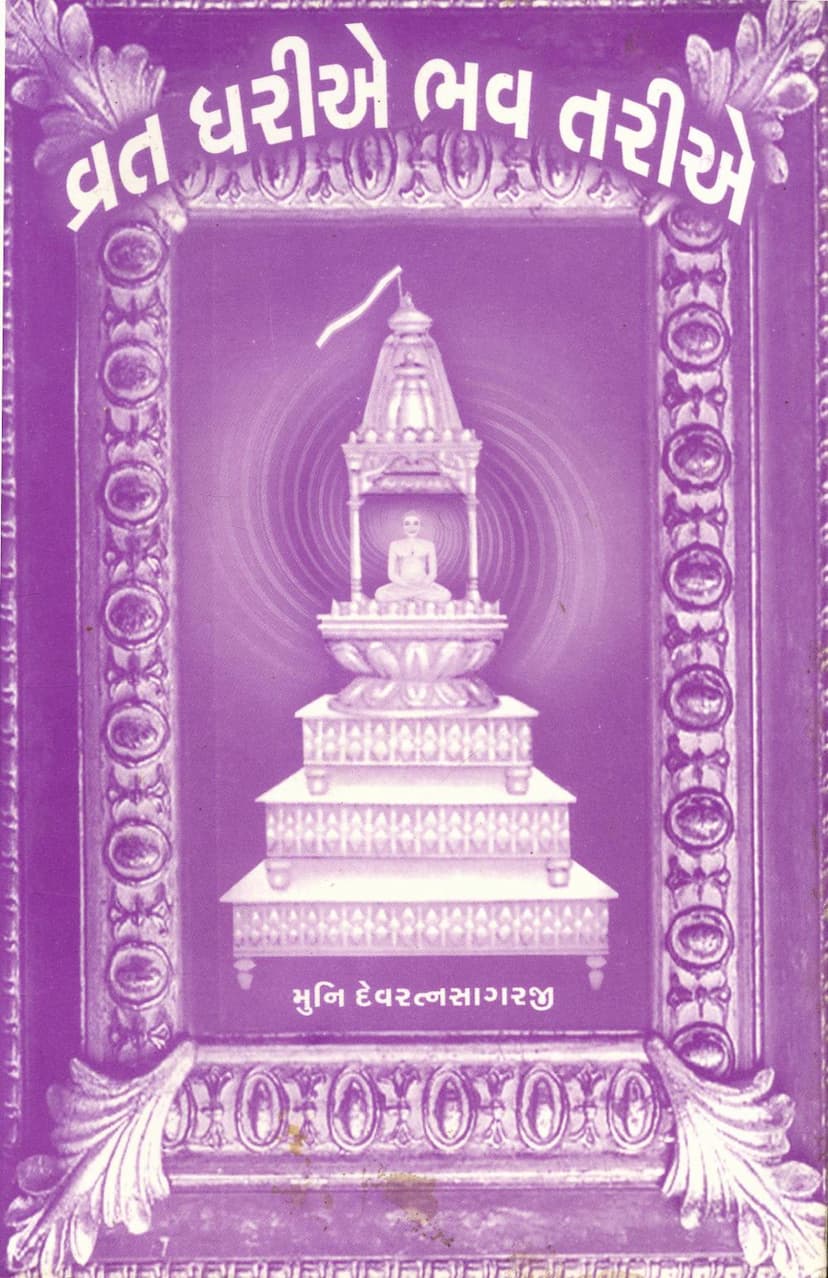Vrat Dharie BhavTarie
Added to library: September 2, 2025

Summary
This Jain text, titled Vrat Dharie BhavTarie (which can be translated as "Those Who Observe Vows, Those Who Experience the Cycle of Birth and Death"), authored by Munishri Devratnasagarji and published by Shrutgyan Prasaran Nidhi Trust, is a profound discourse on Jain philosophy and practice, focusing on the path to liberation.
The book, presented with deep reverence and gratitude to spiritual guides, delves into the essence of living a righteous life in accordance with Jain principles. It highlights the importance of ethical conduct, the pursuit of spiritual knowledge, and the ultimate goal of moksha (liberation) from the cycle of birth and death.
Here's a breakdown of the key themes and teachings presented in the text:
Core Principles and Teachings:
- The Nature of Existence and Suffering: The text frequently reflects on the transient nature of worldly pleasures and the inherent suffering (dukkha) in the cycle of existence. It emphasizes that true happiness lies not in material possessions or sensory gratifications but in spiritual realization.
- The Importance of Vows (Vratas): The central theme revolves around the observance of vows, particularly the 12 vows of a Shravak (lay follower) in Jainism. These vows are presented as essential steps towards purifying the soul and progressing on the spiritual path.
- The Path to Liberation (Moksha): The ultimate aim is to achieve moksha, a state of complete freedom from worldly attachments and the cycle of rebirth. This is attained through right faith (samyakdarshan), right knowledge (samyakgyan), and right conduct (samyakcharitra).
- The Role of the Soul and Karma: The text explains that the soul (atma) is inherently pure and blissful but becomes entangled in the cycle of karma due to ignorance and attachment. It emphasizes the need to shed karmic bondage through ethical actions and spiritual practices.
- The Nature of Desire and Contentment: A recurring message is the insatiable nature of desires (trushna) and the importance of cultivating contentment (santosh). The book illustrates how unchecked desires lead to suffering and hinder spiritual progress.
- The Significance of the Guru and Spiritual Guidance: The text repeatedly stresses the crucial role of a spiritual guide (guru) in illuminating the path to liberation. Reverence and humility towards the guru are presented as fundamental for spiritual growth.
- The Practice of Ahimsa (Non-Violence): Non-violence in thought, word, and deed is a cornerstone of Jainism, and this text underscores its paramount importance in all aspects of life, from dietary choices to business practices.
- The Five Vows (Mahavratas) and Their Significance: While the 12 vows of a Shravak are elaborated upon, the underlying principles of the five Mahavratas (for ascetics) – non-violence, truthfulness, non-stealing, celibacy, and non-possession – are implicitly woven throughout the teachings.
- Detailed Examination of the 12 Vows: The book systematically explores each of the 12 vows, providing explanations, examples, potential transgressions (atichara), and advice on how to observe them with utmost care and diligence. This includes:
- Pranatipt Viraman Vrat (Abstinence from Harming Living Beings)
- Mrushavada Viraman Vrat (Abstinence from Falsehood)
- Adattadan Viraman Vrat (Abstinence from Stealing)
- Brahmacharya Vrat (Celibacy/Chastity)
- Parigraha Pariman Vrat (Limitation of Possessions)
- Dishopariman Vrat (Limitation of Movement/Directions)
- Bhogopabhog Viraman Vrat (Abstinence from Excessive Enjoyment of Objects)
- Anarthadand Viraman Vrat (Abstinence from Useless Activities/Harmful Actions)
- Samayik Vrat (Equanimity/Meditation)
- Paushadh Vrat (Temporary Asceticism/Fasting)
- Deshavkaashik Vrat (Temporary Restraint in Location)
- Atithi Samvibhaag Vrat (Dana - Offering to the worthy)
- The Importance of Purity and Right Intention: The text emphasizes that true spiritual practice lies not just in outward actions but also in the purity of intention (bhava) and the cultivation of virtuous thoughts.
- The Consequences of Actions (Karma): The book highlights the law of karma, where every action has a consequence, shaping one's present and future lives. It encourages careful consideration of one's actions to avoid negative karmic repercussions.
- The Journey from Bondage to Liberation: The text guides the reader on a journey of self-discovery, moving from the state of worldly entanglement and ignorance towards spiritual awareness and eventual liberation.
Structure and Style:
The book appears to be structured as a series of teachings, likely delivered through discourses or lectures, covering a wide range of topics related to Jain ethics, philosophy, and practices. It utilizes:
- Illustrative Narratives and Examples: The text employs numerous stories, anecdotes, and parables to explain complex concepts and make them relatable. These often feature historical figures, kings, disciples, and even animals to convey lessons on morality and spiritual discipline.
- Question and Answer Format: Some sections are presented in a Q&A format, addressing common doubts and queries of the followers, which helps in clarifying the practical aspects of the teachings.
- Emphasis on Caution and Vigilance: A strong emphasis is placed on remaining vigilant against the temptations of the world and the pitfalls that can lead to spiritual downfall.
- Inspirational Tone: The overall tone is motivational and encouraging, urging readers to strive for spiritual progress and to lead a life of virtue and devotion.
Overall Message:
Vrat Dharie BhavTarie serves as a comprehensive guide for Jains aiming to live a life of spiritual discipline and ultimately achieve liberation. It underscores that by strictly observing vows, cultivating virtues, understanding the nature of karma, and following the teachings of the Tirthankaras, one can navigate the complexities of life and attain the highest spiritual goal. The book is a call to action, encouraging sincere practice and unwavering devotion on the path to the divine.